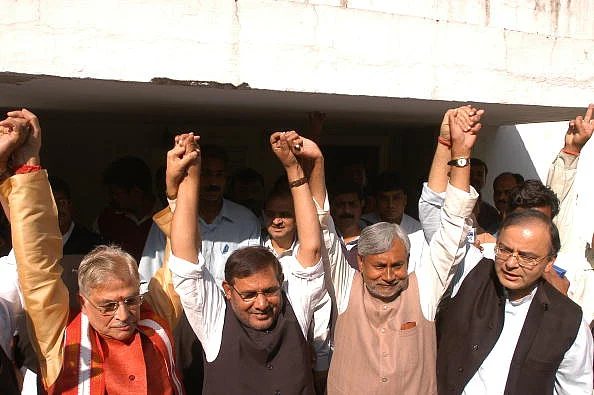1999: A split in the Janata Dal leads to the formation of Janata Dal(United) led by Sharad Yadav, which lent support to the National Democratic Alliance, and the Janata Dal (Secular) under HD Deve Gowda, who chose to remain outside the influence of both Congress and BJP.
2000: Nitish Kumar becomes the CM of Bihar, as a member of the Samata Party, at the bidding of the Vajpayee government. Both NDA and RJD fail to prove majority in the house. Kumar resigns as CM after seven days.
2003: Janata Dal (United) officially formed with JD(U) under Sharad Yadav merging with Samata Party headed by George Fernandes and Nitish Kumar, and the Lok Shakti. The newly formed JD(U) becomes a part of the NDA.
2005: In alliance with NDA, JD(U) defeats Rashtriya Janata Dal-led UPA coalition in the 2005 Bihar Assembly Elections. Nitish Kumar becomes Chief Minister for the second time.
2009: JD(U) in alliance with NDA win 32 seats in the 2009 Lok Sabha Elections, with the JD(U) alone winning 20 seats.
2010: JD(U) in alliance with BJP, in Bihar, win 206 out of 243 in the 2010 Legislative Assembly elections, forming the government for the second consecutive time. Nitish Kumar resumes his CM chair, in his third term.
2013: Ends coalition with BJP in Bihar after 17 years. Breaks away from the NDA. Sharad Yadav steps down as NDA convener.
2014: JD(U) allies with Communist Party of India (CPI) for the Lok Sabha elections. Wins two seats out of 40. Nitish Kumar resigns as the CM. RJD backs JD(U) in the trust vote called by BJP. Jitan Ram Majhi sworn in as new CM of Bihar. Kerala-based Socialist Janata (Democratic) led by M.P. Veerendra Kumar merges with JD(U) marking an important juncture in the party’s pan-India appeal.
2015: Proposal for a Janata Parivar Alliance bringing together JD(U), RJD, JD(S), Samajwadi Party (SP), Indian National Lok Dal and Samajwadi National Party is initiated, but falls apart with SP leaving the national alliance over seat share issues for the 2015 assembly polls. JD(U) becomes a part of the Mahagathbandhan (MGB) and allies with RJD for the Bihar Assembly Elections. Out of the majority of 178 seats won by the alliance, JD(U) wins 71 seats. Nitish Kumar becomes CM again, as Jitam Ram Majhi is expelled from the party.
2017: Nitish Kumar steps down as the CM, ending the Mahagathbandhan with RJD in the state. Takes oath as CM the following day with the renewed support of BJP. Socialist Janata Party under Veerendra Kumar announces split following Nitish Kumar joining hands with BJP. NDA government wins trust vote in the state assembly. Sharad Yadav removed from party owing to engagement in anti-party activities.
2019: NDA wins 39 seats out of 40 from Bihar in the 2019 Lok Sabha polls, with JD(U) securing 16 seats.
2020: The Nitish Kumar-NDA alliance narrowly edges past the MGB alliance in the 2020 Bihar assembly polls winning 125 seats against MGB's 110. Incumbent CM Kumar is elected CM of the NDA government in Bihar.
2022: Nitish Kumar breaks the alliance with the BJP and resigns as chief minister, revoking his party from the NDA. Announcing rejoining Mahagathbandhan comprising RJD, INC, CPI and other independents, a new governing coalition is formed. Kumar is sworn in as the CM of the state for the eighth time in 22 years.
2024: Preceding the 2024 Lok Sabha Polls, JD(U) ends alliance with RJD and INC in Bihar, rejoining the NDA in January. Resigns and retakes oath as CM for the ninth time, supported by the BJP-led NDA.
















